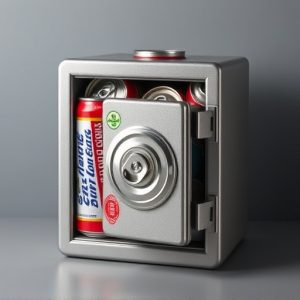Safe Disguised as Everyday Packaging: Hidden Compartments for Secrecy
In today's digital age, hidden wall compartments behind paintings offer a sophisticated solutio…….
In today's digital age, hidden wall compartments behind paintings offer a sophisticated solution for enhancing privacy and security by discreetly storing valuable items and sensitive documents within seamlessly integrated art pieces. This innovative approach, leveraging everyday objects like paintings as decoys, ensures peace of mind while maintaining aesthetic appeal, making it ideal for both residential and professional settings. While raising ethical considerations around sustainability and consumer consent, the use of hidden wall compartments behind paintings balances privacy, safety, and transparency in modern packaging design.
In a world where discretion is key, innovative designers have masterfully blended safety with everyday product packaging. This article delves into the intriguing concept of hidden compartments—discreet storage spaces cleverly integrated into ordinary items. From creative camouflage techniques to the artistic allure of painted walls as hiding places, we explore how these concealed areas offer both security and a unique twist on traditional design. Uncover the benefits, applications, and ethical considerations of this fascinating approach, where safety seamlessly merges with plain-sight disguise, notably highlighted by hidden wall compartments behind paintings.
- Unveiling Discreet Storage: The Concept of Hidden Compartments
- Everyday Items as Decoys: Creative Camouflage Techniques
- Painting as a Canvas: Exploring the Hidden Wall Compartment Design
- Benefits and Applications: Why Disguise Security in Plain Sight?
- Ethical Considerations: Balancing Privacy, Safety, and Artificially Enhanced Packaging
Unveiling Discreet Storage: The Concept of Hidden Compartments
In today’s world, where privacy and discretion are increasingly important, the concept of concealed storage has gained popularity. Unveiling discreet storage solutions involves integrating secure hiding places within everyday products, turning ordinary items into trusted guardians of our secrets. One innovative approach is the integration of hidden wall compartments behind paintings, offering a sophisticated means to store valuable items or sensitive documents.
This clever design tactic leverages the natural concealment provided by artwork, allowing for seamless integration that goes unnoticed. By strategically placing a painting with a thin, hollow backing, artisans and designers can create accessible storage spaces within the home or office. This method ensures that personal belongings, important papers, or even emergency supplies are kept out of sight but easily reachable, providing peace of mind and an added layer of security.
Everyday Items as Decoys: Creative Camouflage Techniques
In the world of espionage and stealth, everyday items serve as ingenious decoys to disguise hidden compartments and secret storage spaces. One innovative technique involves integrating concealed pockets or cavities into seemingly ordinary products, such as paintings or books. For instance, a canvas painting might hide a small wall compartment, allowing for the safe storage of sensitive materials or valuable items. This creative camouflage ensures that the item looks harmless and unassuming, making it an excellent method to conceal secrets within plain sight.
These decoy devices require intricate craftsmanship and clever design thinking. Craftspeople meticulously craft these products to mimic their intended everyday counterparts while incorporating hidden spaces. For example, a faux book with pages that open to reveal a secret compartment is a fascinating way to hide valuables or confidential documents. Such techniques showcase the fusion of art and engineering, transforming ordinary objects into sophisticated tools for secrecy and security.
Painting as a Canvas: Exploring the Hidden Wall Compartment Design
In the realm of innovative security solutions, the everyday act of painting takes on a new dimension—a hidden canvas for concealed storage. The concept is simple yet ingenious: integrate a secret compartment behind a painted surface, offering a discrete space to hide valuable items or sensitive materials. This design approach leverages the common practice of decorating walls with paint, transforming it into a functional feature.
Imagine a painting that, at first glance, appears to be a beautiful addition to any room, but in reality, serves as an access point to a hidden wall compartment. The artful placement of these compartments ensures they remain undetected, making them ideal for securing personal belongings or important documents. This unique approach not only adds aesthetic value but also provides a creative solution for those seeking discreet storage options.
Benefits and Applications: Why Disguise Security in Plain Sight?
In today’s world, where security concerns are ever-present, finding creative ways to hide valuables and sensitive items has become a priority for many. Disguising security measures as everyday product packaging offers an innovative solution that keeps treasures safe while maintaining an unassuming exterior. One such example is the hidden wall compartment behind painting—a subtle yet effective way to store objects discreetly.
This approach provides numerous advantages. For instance, it allows individuals to protect their belongings without drawing attention, making it ideal for high-value items or confidential documents. Whether it’s a precious collection of art, rare coins, or important legal paperwork, hiding them within seemingly innocuous packaging like paintings ensures they remain secure and out of sight. This method also adds an extra layer of protection against theft or accidental discovery, offering peace of mind for those seeking to safeguard their possessions in plain sight.
Ethical Considerations: Balancing Privacy, Safety, and Artificially Enhanced Packaging
In the pursuit of enhancing privacy and ensuring safe storage, the concept of disguised packaging has gained traction. However, ethical considerations come into play when exploring this tactic. On one hand, integrating hidden compartments, like a hidden wall compartment behind painting, offers an innovative solution for secure hiding places. This can be particularly appealing in contexts where discretion is vital, such as storing sensitive documents or valuable items.
Yet, the very nature of artificial enhancement in packaging design raises questions about sustainability and consent. The environmental impact of creating aesthetically pleasing yet functional disguise mechanisms should not be overlooked. Moreover, consumers have the right to know if they are purchasing a product with intentionally concealed features. Striking a balance between privacy, safety, and transparency is crucial to ensuring ethical practices in this innovative approach to packaging design.
In today’s world, where privacy and security are paramount, the art of disguising safe storage within everyday product packaging has emerged as a unique solution. From hidden wall compartments behind paintings to creative camouflage techniques, these innovative designs offer both aesthetic appeal and robust security. While the benefits are clear, ethical considerations regarding artificially enhanced packaging must be carefully navigated. Ultimately, striking a balance between privacy, safety, and artistic expression is crucial for this game-changing approach to secure storage solutions.


